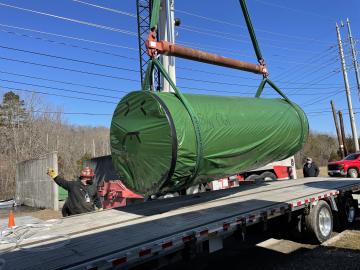Filter News
Area of Research
- Advanced Manufacturing (1)
- Biology and Environment (23)
- Clean Energy (21)
- Computational Biology (1)
- Fusion and Fission (7)
- Fusion Energy (1)
- Isotopes (7)
- Materials (3)
- Materials for Computing (4)
- National Security (3)
- Neutron Science (6)
- Nuclear Science and Technology (1)
- Quantum information Science (2)
- Supercomputing (12)
News Type
News Topics
- 3-D Printing/Advanced Manufacturing (7)
- Advanced Reactors (1)
- Artificial Intelligence (4)
- Big Data (2)
- Bioenergy (9)
- Biology (14)
- Biomedical (6)
- Biotechnology (3)
- Buildings (5)
- Chemical Sciences (2)
- Clean Water (3)
- Climate Change (3)
- Computer Science (14)
- Coronavirus (3)
- Cybersecurity (1)
- Decarbonization (5)
- Energy Storage (8)
- Environment (23)
- Exascale Computing (2)
- Frontier (1)
- Fusion (1)
- Grid (3)
- High-Performance Computing (9)
- Isotopes (6)
- ITER (1)
- Materials (4)
- Materials Science (7)
- Mercury (3)
- Microscopy (3)
- Nanotechnology (3)
- National Security (4)
- Neutron Science (7)
- Nuclear Energy (4)
- Physics (2)
- Polymers (1)
- Quantum Computing (1)
- Quantum Science (4)
- Security (2)
- Space Exploration (1)
- Summit (4)
- Sustainable Energy (9)
- Transportation (9)
Media Contacts

A 25-year career with the U.S. Navy, commanding combat missions overseas, brought Tom Kollie back to where he came from — ready to serve his country in a new way.

Moving to landlocked Tennessee isn’t an obvious choice for most scientists with new doctorate degrees in coastal oceanography.

As a medical isotope, thorium-228 has a lot of potential — and Oak Ridge National Laboratory produces a lot.

Improved data, models and analyses from ORNL scientists and many other researchers in the latest global climate assessment report provide new levels of certainty about what the future holds for the planet

As the United States transitions to clean energy, the country has an ambitious goal: cut carbon dioxide emissions in half by the year 2030, if not before. One of the solutions to help meet this challenge is found at ORNL as part of the Better Plants Program.

The receipt of a nuclear fuel canister is boosting the research of an Oak Ridge National Laboratory team investigating methods to help the nation effectively dispose of nuclear waste for the long term.

Four first-of-a-kind 3D-printed fuel assembly brackets, produced at the Department of Energy’s Manufacturing Demonstration Facility at Oak Ridge National Laboratory, have been installed and are now under routine operating

As a metabolic engineer at Oak Ridge National Laboratory, Adam Guss modifies microbes to perform the diverse processes needed to make sustainable biofuels and bioproducts.

Long before COVID-19’s rapid transmission led to a worldwide pandemic, Oak Ridge National Laboratory’s Jason DeGraw was performing computer modeling to better understand the impact of virus-laden droplets on indoor air quality

David Sholl has come to the U.S. Department of Energy’s Oak Ridge National Laboratory with a wealth of scientific expertise and a personal mission: hasten the development and deployment of decarbonization solutions for the nation’s energy system.




